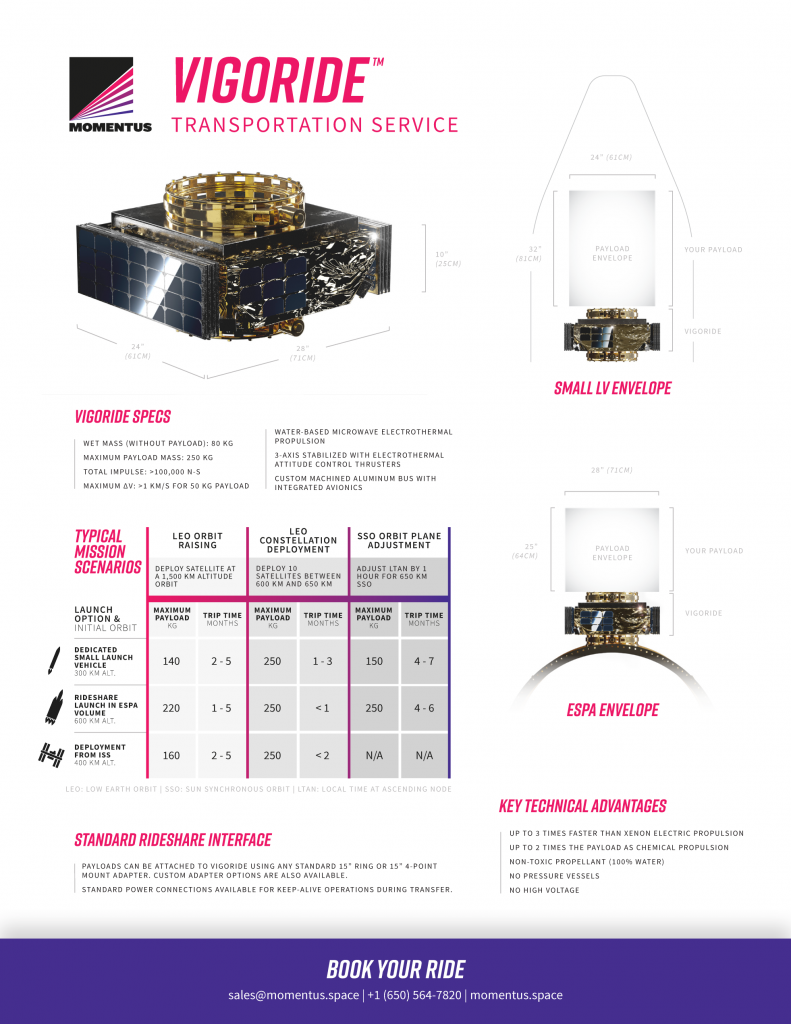On August 22nd, spaceflight startup Momentus Space and launch heavyweight SpaceX announced the first public launch contract to fall under the umbrella of the latter company’s recently-announced Satellite Rideshare Program.
Meant to provide a reliable, consistent, and affordable form of shuttle-like access to orbit, SpaceX’s rideshare program will – pending demand – involve no less than one dedicated Falcon 9 launch per year, capable of placing 15+ metric tons (33,000+ lbs) into low Earth orbit. Although SpaceX’s rideshare proposal is far from revolutionary, the company’s contract with Momentus Space appears to be more than a basic launch service agreement, potentially opening doors for far more flexible rideshare launches in the future.
Since its November 2017 founding, Momentus Space has been able to put money where its mouth is far more so than any comparable space tug hopeful, of which there are several. The concept that has helped Momentus raise nearly $34M in just 1.5 years is relatively simple: build a spacecraft whose sole purpose is to propel other spacecraft to their final orbit(s).
Known as a space tug, the concept is about as old as practical spaceflight itself, and interest in actually developing the concept from paper to hardware has grown exponentially in the last 5-10 years, thanks in large part to an unprecedented boom in commercial spaceflight activity. Applied more specifically, modern efforts like Momentus tend to have ambitious goals couched behind much more achievable (and marketable) concepts.


Momentus Space’s first goal is to bridge the gap between the low cost of smallsat rideshare missions on large rockets and the convenience of smallsat launches on much smaller rockets by building lightweight, simple, and cheap orbital tugs. The first tug the company wants to field is called Vigoride and will measure approximately 2ft x 2ft (0.4m²) and weigh just 80 kg (175 lb) fully fueled. If launched to a 600 km (370 mi) sun-synchronous orbit (SSO), Vigoride will be able to deliver as much as 220 kg (~500 lb) to a final circular orbit of ~1500 km (930 mi) or place 250 kg (550 lb) of satellites into 10+ separate orbits.

Water plasma rockets (!?)
By far the most innovative and potentially revolutionary aspect of Momentus’ plans is its custom propulsion system of choice: water plasma rockets. In simple terms, Momentus space tugs would quite literally turn water and sunlight into a method of in-space propulsion that can offer both moderate efficiency and relatively high thrust. Using solar arrays, the space tug would charge batteries that would then power an extremely high-power microwave electrothermal thruster (MET).
In the case of Momentus, the exotic form of propulsion uses microwaves to almost instantaneously turn liquid water into plasma, an ionized, electrically-charged gas that can then be directed with a magnetic nozzle to produce thrust. Aside from the decent performance it offers, water-based MET allows a given satellite to completely avoid heavy pressure vessels, doesn’t require extremely high voltages, and uses a fully non-toxic propellant (water).

The fact that pure water is so incredibly benign, non-toxic, and accessible opens up a realm of possibilities. Momentus already has plans to launch Vigorides from the International Space Station, and that could eventually expand into actual in-space reuse in which water-powered satellites might dock with the ISS to load more water and pick up new payloads.
In the case of SpaceX, it appears that the company has inked a more two-way agreement with Momentus, in the sense that prospective customers of SpaceX’s Satellite Rideshare Program might actually be able to arrange for their satellites to be included on Vigoride. Vigoride would then be able to deliver each payload – up to 250 kg worth – to its own orbit, potentially far more convenient than simply being kicked off at a lone orbital bus stop. As Momentus matures its technology and moves from Vigoride to Vigoride Extended and beyond, a partnership with SpaceX’s Satellite Rideshare Program could grow into an almost unbeatable turnkey option for the smallsat industry.

Momentus took its first major step towards building capable and marketable space tugs in July 2019 when the company launched X1, its first orbit-worthy satellite prototype. Although the company has been dead silent as to the actual status of that prototype, even a failure would still serve as an invaluable learning opportunity, even if it would be an inconvenient setback. Vigoride’s first test flight was planned as early as late 2019, although the status of that schedule is uncertain.
Check out Teslarati’s newsletters for prompt updates, on-the-ground perspectives, and unique glimpses of SpaceX’s rocket launch and recovery processes.

<!–
–>
var disqus_shortname = «teslarati»;
var disqus_title = «SpaceX’s Falcon 9 rideshare program secures its first customer»;
var disqus_url = «https://www.teslarati.com/spacex-momentus-space-tug-first-falcon-9-rideshare/»;
var disqus_identifier = «teslarati-112482»;

